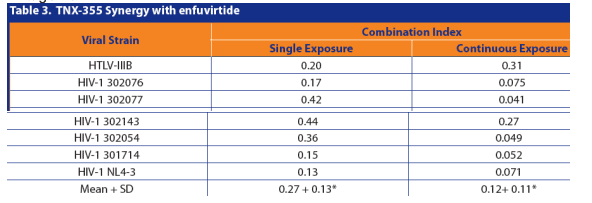 |
 |
 |
| |
In Vitro Antiretroviral Activity of the Humanized Anti-CD4 Monoclonal Antibody, TNX-355, against CCR5, CXCR4, and Dual-Tropic Isolates and Synergy with Enfuvirtide
|
| |
| |
Reported by Jules Levin
ICAAC Dec 18, 2005 Wash DC
Poster No. 3844
E. GODOFSKY1, X. ZHANG2, M. SORENSEN3, M. FUNG4, T. DUENSING4, S. T. LEWIS4, R. T. SCHOOLEY2
Bach and Godofsky, Bradenton, FL1, Univ. of California, San Diego, CA2, Dartmouth Med. Sch., Hanover, NH3, Tanox, Inc., Houston, TX4
Introduction
TNX-355 is a humanized monoclonal antibody that binds to a unique epitope in domain 2 of human CD4, which is believed to be involved in the conformational change required for post-binding HIV-1 entry into target cells (1, 2). Clinical trials have shown TNX-355 to be safe and efficaceous in treating HIV infected patients (3, 4, 5). Recent clinical trials have also demonstrated that agents that block the binding of HIV-1 to chemokine co-receptors (SCH 351125 or AMD 3100) or prevent reconfiguration of the gp41 molecule (enfuvirtide) significantly reduce the replication of HIV-1 in vivo (6-9). These observations have been complemented by a series of in vitro studies that demonstrate that antiviral agents acting
at several steps of the entry cascade exhibit substantial antiviral synergism (10, 11).
Coreceptor inhibitors are potentially constrained by viral tropism. Since TNX-355 blocks entry by targeting the primary receptor, it is anticipated that its activity would not be limited by tropism constraints. To examine this, we tested the relationship between HIV-1 co-receptor tropism and susceptibility to TNX-355 in HIV-1 isolates from patients enrolled in a phase 1b clinical trial (3). In addition, because the combination of inhibitors targeting different steps of the entry process represent potentially powerful combination therapy, we tested the the in vitro cooperativity between TNX-355 and enfuvirtide.
Discussion/Conclusions
--TNX-355 exhibits potent antiviral activity against CCR5, CXCR4 and dual/mixed tropic HIV isolated from infected patients.
--Sensitivity was maintained when individual subclones exhibiting CCR5, CXCR4 or dual tropism were tested.
--Coreceptor tropism should not be a limiting factor for inclusion of TNX-355 in a combination regimen.
--TNX-355 exhibits synergistic antiretroviral activity with enfuvirtide against both laboratory and clinical strains of HIV-1.
These data support an antiviral strategy of combining agents directed at sequential steps of the viral entry process.
Results
Pseudotyped viruses expressing envelope genes were isolated from patient plasma and used to infect U87 cells expressing CD4 plus CCR5 or CXCR4. TNX-355 concentrations required for achieving 50% inhibition (IC50) were determined from TNX-355 dose response curves in the PhenoSense Entry assay (Monogram Biosciences, Inc.).
Combination indices:
Synergy <0.9
Additive 0.9 to 1.1
Antagonism >1.1

Synergistic antiretroviral activity was demonstrated between TNX-355 and enfuvirtide in multiple strains of HIV. Combination indices were calculated for each of the viral strains tested. Combination indices of 0.13 to 0.44 were observed when the two agents were included during the initial 18 hours of tissue culture in checkerboard titrations. Combination indices indicated a much greater degree of synergy when both agents were present throughout the culture period. The combination index was calculated by the Chou median-effect principle.
Individual subclones expressing Env were isolated from pooled patient isolates. 12 subclones from each patient were tested for susceptibility to TNX-355 using the PhenoSense Entry assay. Coreceptor tropism was determined by infecting
U87 cells expressing either CCR5 or CXCR4. The susceptibility of subclones were reported in tables & appeared susceptible to TNX-355 but tables are too large to show here.
Methods
entry assays: The in vitro susceptibility of viruses isolated from patients was determined using the PhenoSense HIV Entry Assay, a single-cycle infectivity assay developed, validated and performed by Monogram Biosciences, Inc. This assay uses recombinant viruses that express patient-derived HIV envelope proteins to evaluate entry inhibitor drug susceptibility and coreceptor tropism (12).
synergy assays: Three day PHA blasts (2 x 106) were incubated with HIV-1 (100 TCID50) plus drug in 2.0 mL medium overnight in 24-well tissue culture plates at 37 C in a humidified 5% CO2 atmosphere. PBMCs were washed three times in PBS and resuspended in 2 mL R-3 medium with or without replacement of TNX-355. 0.5 mL cell-free culture supernatant fluids were harvested from each well and analyzed for HIV-1 p24 antigen production by enzyme-linked immunosorbent assay (Beckman Coulter, Miami, Florida) on day 4, 7 and 10 of culture. 0.5 mL fresh R-3 medium with or without replacement of TNX-355 was added on days 4 and 7. The 50% neutralization concentration (IC50) was calculated using the Chou dose-effect equation (10). In synergy studies, virus was cultured in the presence of either a single drug or combination of drugs in a checkerboard combination design of a range of concentrations. The IC50 and the Combination Index (CI) values were calculated using the Chou dose effect equation (13). By convention, a CI<0.9 indicates synergy, 0.91.1 indicates antagonism.
|
|
| |
| |
|
 |
 |
|
|